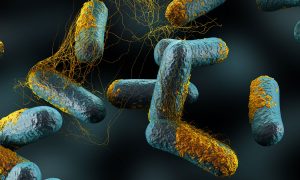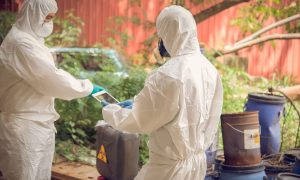Bioterrorism is the deliberate and planned use of pathogenic strains of microorganisms such as bacteria, viruses, or their toxins to spread potentially fatal diseases on a large scale in order to devastate a population. Historically, mankind has been at risk from biological weapons for many centuries. Back then, water sources were contaminated using really primitive techniques like feces, animal corpses, etc., but today, highly concentrated biological agents are available, such as dried spores and genetically modified organisms, which are lethal even in minute quantities. These substances are normally found in nature, but it is possible that they may be altered to make them more virulent, resistant to treatment, or more easily disseminated throughout the ecosystem.
Zoonotic organisms are the primary source of bioterrorism threats. As a result, deployment of such an agent to attack human populations would probably put the health of local animal populations at risk, including pets that could serve as sentinels for the human population. If the clinical symptoms of a zoonotic disease can be identified before human illness manifests, pets can provide humans with an early warning so that prophylactic or protective measures can be taken. Early detection might be achievable if an animal species is more prone to a given agent, the disease it causes has a shorter incubation time, or animals are exposed earlier (or at higher intensities or continuous levels) than humans.

The simultaneous onset of disease signs and symptoms in animals may help to more quickly identify biological warfare that causes non-specific consequences in people. In addition, careful monitoring for the sporadic animal disease could aid in identifying any ongoing exposure risk if a biological agent that has been discharged stays in the environment (such as soil, water, or air). Furthermore, the geographic dispersion of sick or dead animals can be a sign that a biological threat is still present.
Bioterrorism Categories:
Bioterrorism agents can be separated into three categories, depending on how easily they can be spread and the severity of illness or death they cause.
Category A: High-priority agents that can quickly spread or be transmitted from one person to another, produce high death rates, or have the potential to have significant public health effects and constitute a threat to national security. They may result in social unrest and widespread fear, necessitating significant preparation for public health.
Agents/diseases included in this category include the following:
- Anthrax (Bacillus anthracis),
- Botulism (Clostridium botulinum toxin),
- Plague (Yersinia pestis),
- Smallpox (Variola major),
- Tularemia (Francisella tularensis), and
- Viral hemorrhagic fevers [filoviruses (e.g. Ebola, Marburg) and arenaviruses (e.g. Lassa, Machupo)].
Category B: The second highest priority agents are those that are moderately easy to disseminate and have moderate morbidity and mortality rates.
Agents/diseases included in this category include the following:
Brucellosis (Brucella species)
Epsilon toxin of Clostridium perfringens
Food safety threats (e.g., Salmonella species, Escherichia coli O157:H7, Shigella)
Glanders (Burkholderia mallei)
Melioidosis (Burkholderia pseudomallei)
Psittacosis (Chlamydia psittaci)
Q fever (Coxiella burnetii)
Ricin toxin from Ricinus communis (castor beans)
Staphylococcal enterotoxin B
Typhus fever (Rickettsia prowazekii)
Viral encephalitis (alphaviruses [e.g., Venezuelan equine encephalitis, eastern equine encephalitis, western equine encephalitis])
Water safety threats (e.g., Vibrio cholerae, Cryptosporidium parvum)
Category C: Emerging pathogens are the third-highest priority agents because of their availability, ease of production and dissemination, the potential for high morbidity and mortality rates, and major health impact.
Nipah virus, Hantavirus, and Mycobacterium tuberculosis come under this category.

What are the effects of Bioterrorism?
Mass casualties, pandemic disease, illness among healthcare workers, environmental contamination, legal problems, and discomfort within the medical and general public are all potential outcomes of bioterrorism and other high-consequence biological occurrences.
Compared to other combat kinds, biological warfare has complicated and long-lasting relationships with the environment (conventional, nuclear, and chemical). Biological weapons could affect a wide range of targets, could spread readily through food and water, insect vectors, or an aerosol, could have a variety of ways to enter targets, and could even be employed by inexperienced terrorists. Along with natural disturbances and disasters, environmental changes also include artificial changes that have an impact on human ecology, human-created ecosystems, and landscape ecology.
The transmission cycles of infectious pathogens may change as a result of changing environmental processes. The pathogens and parasites that reproduce, develop, and transmit disease are impacted by these changes, as well as the hosts or disease vectors. The most ecologically complicated infectious illnesses are usually vector-borne zoonoses, where environmental change may have the widest variety of consequences, some of which may increase transmission and others which may decrease it. Disease outbreaks may result from reduced ecosystem buffering caused by habitat and species loss. Last but not least, the coexistence of novel vectors, hosts, and parasites in damaged ecosystems offers the possibility of the emergence of fresh routes of transmission and new “emerging illnesses.”
Species of wild plants and animals that are naturally scarce as well as those whose numbers have been drastically reduced due to overharvesting or habitat degradation are especially vulnerable to extinction due to introduced diseases. Innocent and vulnerable wildlife populations may experience catastrophic mortality from diseases to which humans and human commensals have acquired immunity or high degrees of resistance.
The impacts of canine distemper on the African wild dog (Canis lupus), the Caspian seal (Phoca caspica), and the North American black-footed ferret (Mustela nigripes) serve as examples of the potentially devastating harm that even isolated disease outbreaks can cause on endangered animals (Lycaon pictus). Canine distemper is a widespread viral illness that affects domestic dogs and can spread to wild carnivore animals, where it can have horrifying effects. Unsettlingly, bioweapons research labs have also produced and studied canine distemper as a disease. The last known wild population of the North American black-footed ferret and the African wild dog population in Tanzania’s Serengeti National Park perished due to canine distemper epidemics over the past ten years.
Agents of biological warfare pose intricate psychosocial difficulties for civilian populations. Uninfected people may mistakenly ascribe panic and arousal symptoms to biological agents in a biological weapon assault, which would put an immediate strain on medical services. There will undoubtedly be distress everywhere. Pneumonic plague broke out in Surat, India in 1994, causing widespread terror and a huge migration that included some medical staff. The idea of being infected by a silent, odorless, tasteless, and unseen germ or virus inspires magical thinking and can conjure up gruesome images in the mind. Both sick and non-infected people will seek medical attention out of fear of infection. There will be widespread exposure to death, the dead, and terrible bereavement.

How to prevent bioterrorism?
Obviously, the ideal way to avert a problem is to stop a biological attack before it occurs. By dramatically improving our intelligence, we can stop the spread and use of biological weapons in the first place. To improve the quality of data gathering and processing, the intelligence community may use more scientific and medical knowledge. Greater cooperation and trust between the intelligence community, law enforcement, public health, and biological science will be necessary for this.
In order to prevent the development of new and more harmful creatures, caution must be exercised when using the instruments of contemporary genomic biology. This is a difficult challenge because nobody wants to obstruct the advancement of significant and reputable knowledge. We must keep limiting access to harmful viruses by assisting the scientific community in enhancing security and ensuring the secure handling and storage of these materials. These are significant efforts, but more can and ought to be done to guarantee that the use and storage of these materials in our country’s laboratories are adequately regulated. Achieving these objectives will require international cooperation. If the safety and control techniques created for domestic use are to have a significant and long-lasting impact, they must be applied globally.

Though preventing future bioweapons attacks may not be possible, careful planning and preparation might significantly reduce the amount of pain and death that would be caused. In order to handle the threat of bioterrorism as a nation, we need comprehensive, integrated planning that focuses on both prevention and response.
References:
- https://www.ncbi.nlm.nih.gov/pmc/articles/PMC3633289/
- https://www.sciencedirect.com/topics/earth-and-planetary-sciences/bioterrorism
- https://www.ncbi.nlm.nih.gov/pmc/articles/PMC7152325/
- https://academic.oup.com/bioscience/article/52/7/583/247983
- Psychological Effects of Biological Warfare. Contributors: COL Ann E. Norwood, MC USA; COL Harry C. Holloway, MC USA (Ret.); Col Robert J. Ursano, USAF MC FS (Ret.). MILITARY MEDICINE, 166, Suppl. 2:27, 2001
- https://issues.org/p_hamburg/

MDForLives is a vibrant community of healthcare professionals and patients dedicated to shaping the future of healthcare. We provide valuable global insights to healthcare companies through online surveys, interviews, and discussion forums.






